Where all the fun happens.
Dropping knowledge left and right. But mostly left.
Selling Experiences – Ralph Sheheen at RPM Recap
If you’ve been around these parts long – that sounded very Southern…I feel like there needs to be a ‘y’all’ inserted here – you know that I believe pretty heavily in thinking not just outside of the box, but outside of our industry for ideas on how to survive and thrive. That’s how the best do it.
After all, we’re not competing against other race tracks for fans. We’re competing against every other activity they’re choosing to do or not do.
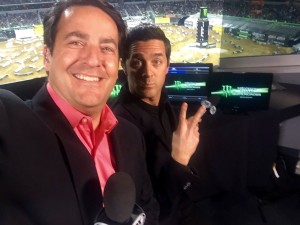
Ralph announcing at a recent Supercross Live event.
So I was really happy to get to listen to Speed Sport’s own Ralph Sheheen last week at RPM Daytona talking about exactly that. Specifically, he highlighted his experience with and observations of the AMA Supercross events.
Here are a few things that I took away from his talk that I think you’ll benefit from, whether it’s as an event promoter, racer or marketing partner:
- The emphasis at Supercross Live is, first and foremost, on families. It’s family-friendly, from the advertising to the event experience. If you have, or are observing, an aging fan base, you can presume that they are lifelong fans. This sport isn’t built for an aging demographic, so you can guarantee they didn’t just walk in for the first time last race. If you want to create lifelong fans today, you have to get them in young. Appealing to young fans and parents, who are constantly looking for outlets to entertain their children in a safe, fun, cost-effective activity, you need to be family-friendly from the outset.
- They only have two racing classes. [Oh. My. Word. Did y’all just die?! Stay with me here.] This is a huge mistake that I see many tracks making to benefit them in the short-term – just add another class to the back-gate. This works for a little while, because you sell more pit passes, and those are more expensive and easier to sell than grandstand tickets. What could go wrong?! It doesn’t take long for fans to be driven right out of their seats and to a two-hour movie at half the price of your ticket when they can’t get their kids in bed by 11pm. It’s a self-perpetuating cycle – add more classes, lose more fans, add more classes to make up the difference. It also drives your premier racers away over the long run – the ones that the fans who do stick with you are most likely there to see – because they can travel to other race tracks with half the number of divisions and be home before your program is done. True, real-life story. Two classes might not be feasible, but seven or eight isn’t either. Choose wisely.
- They’re done by 10pm. ‘Heads would roll’, as Ralph described, if this wasn’t the case at Supercross Live. Because I don’t ride in our rig on Friday nights, I can stay for the majority of the program at Lernerville Speedway and be home, showered and in bed by 11pm on most nights. I’m getting pretty close to the majority of fans’ experience there. Sure, fans will stay out late for a special event every once in a while. But they won’t do it for weekly racing, especially if they have kids. And if Supercross Live, which is a rare special event for most families, thinks it’s that important, shouldn’t we?
- They build relationships between the fans and the racers. From my notes, Ralph described that from noon to 5pm, the Supercross events have a ‘pit party’, where fans can go directly to all of the rider’s pit areas and get more than just a glimpse of their heroes with their helmets off. Each of the drivers has an autograph session at every event. When the riders are introduced for the first time (with tons of pyrotechnics and fanfare, by the way), many of them are shown in the stands, among the fans, instead of with their helmets on, perched on their bikes on the track. And, speaking of the track, they provide an open track walk opportunity before the event, which helps fans to understand exactly how difficult it is for riders to conquer the turns and jumps before they watch them – increasing appreciation for the skill it takes.
- They emphasize quality. They offer quality merchandise with designs that fans want to wear every day, not just to the race track, and at the same price that you and I are used to paying. (Side note: they also market their riders’ merchandise, not just their own. They get a piece of the sale, and the teams likely generate more sales. Win-win.) They offer quality food – can someone say ‘kobe beef burgers’?! – that has benefits to the fans, whether that’s in brand recognition, quality ingredients, kid-friendly or healthy. It might not be feasible to completely overhaul your track’s menu, but perhaps you could add a high-quality pre-packaged salad, or an outside food vendor that offers fresh options or a high-end coffee bar, to serve customers who are willing and ready to spend more?
- They activate the region and their partnerships. When Supercross Live comes to town, you know it. You see the commercials on television. You probably see a Facebook ad or ten. You might see tickets available at local retail outlets, autograph signings and hospitality offerings. This not only increases tickets sales, but also allows them to activate their marketing partnerships with more than just signage. Want to get into a Supercross pit party for free? Just bring a can of Monster Energy drink, the series’ title sponsor. Talk about track-able, sales-generating activation.
When fans buy a ticket, whether it’s for themselves or for their whole family, they are buying an experience. (Over the past 10 years, psychological studies have shown that people find more happiness buying experiences, not things, and are shifting purchasing behavior to reflect that. Aren’t we positioned perfectly?!)
Do you think that one or more of the observations above could be applied to give your fans a better experience? And, to take it one HUGE step further, can you be using your marketing to reflect these better experiences so you’re not just keeping current customers happy but also attracting new ones?
Racers: how can you be using this information to your advantage? Can you offer more live experiences for your fans and marketing partners? Can you be more family-friendly? Can you make better, higher-quality merchandise or content? Can you share this with your favorite track so that they can grow and maybe even help sell you to fans?
xo.
Kristin
Do Social Media Policies Help or Hurt?
This week, I got to travel to Florida to speak at the RPM Promoter’s Workshops. My presentation was on social media, and how tracks can use Facebook in particular to succeed in promoting their events.
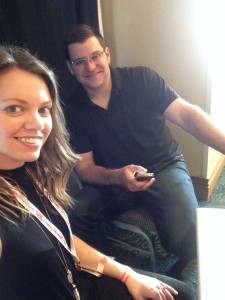
Prepping for my speech with Carl Bowser at RPM Daytona.
It was fun to get to talk to a lot of tracks who were more interested and active on social media than even a year ago, and hear about their insights. And some promoters even got up and shared the results they’d gotten based on my training or advice with the nearly two hundred other promoters in the room, which meant more to me than any of them know.
Social media was definitely hotter topic than last year, and there was one topic that was particularly popular among those who are still unsure about social media’s place in the sport or are outraged by what some tracks are doing. They came to me through two questions:
- What do you think of the controversial ‘social media policies’ that some tracks are adopting, banning or fining those who share negative opinions about the track on social media?
- What do you think of industry members – fans, teams, media and tracks – who criticize the sport on social media?
I loved taking part in these discussions – mostly because they were asking the questions in the first place. Most of those asking knew that social media was a powerful tool, had heard the arguments of those who fear the effects of social media and were open to a discussion on the opposing side, which was very exciting to me.
Some were even looking for tips on what to say to their peers who supported those policies or anti-social-media sentiments.
Here what I shared with them: I fear for any sport (or industry, government or group of people) that ‘bans’ negative feedback.
It tells customers, and potential future customers, that we don’t care what they think. That we’re not open to improving. That if they want to give us their money, that’s fine, but they’re going to take what we give them in exchange for it and like it. Or don’t come back.
Or, if you dare to complain about it, you won’t even be allowed to come back even if you wanted to. Which seems unlikely at this point.
When things don’t go right, whether it’s in your control or not, paying customers have the right to be unsatisfied with that experience.
I understand that you probably worked hard to provide them with the experience that they had, and it can be frustrating that wasn’t received well. What we have to understand is that they also worked hard for the money they shelled out to be a part of your event, whether they’re a ticket holder or a racer.
(Note – racers are customers, too. You’re paying them to put on a show, but you’re not their ’employer’ when the amount of money they have to spend to do their ‘job’ far outweighs what you pay them directly. Mind you: I think that’s okay – that’s how the ecosystem works. Tracks generally provide the venue and marketing partners, team owners and drivers generally pay the bills. Those people are who racers answer to. More thoughts about that purse/cost gap can be found here.)
When we accept money for a product or service, we then owe our customers a level of accountability. Open dialogue – social media and otherwise – allows for that.
What keeps us coming back as customers even after a bad experience at a store, restaurant or race track is the feeling that it was a one-off problem and we can expect better next time. If we don’t allow negative feedback, customers won’t believe they can expect anything but more of the same in the future. And they won’t come back. And they definitely will discourage others from making the same mistake they did.
I agree that ‘bashing’ on social media isn’t good for the sport. But there’s a huge difference between ‘bashing’ and constructive criticism.
There will always be people who bash – with or without any sense of reason. You can’t escape that. But if you’re building an open line of communication with your fans, you’ll find that even when you make mistakes, you’ll have more supporters standing up for you than customers turned away by a basher’s sentiments.
The most powerful form of marketing is word of mouth.
I think that’s what scares fearful promoters most about social media – they can’t control what the public is seeing, unless they create a policy.
But an open door builds community. It builds loyalty and support. It builds a fan base.
Sure it can force us to take a good, hard look at our endeavors at times. But might that be exactly what we need?
Without constructive feedback and improvements that reflects what our customers want, your business risks dying a (silent) death. I don’t know about you, but I’d rather have a chance to improve and grow into something better than I even imagined (that’s what customer feedback can do for you!) than be right and out of business.
xo.
Kristin
RPM Talk at Daytona: Crushing it with Social Media
Next week, I’ll be making a quick trip down to Florida for the RPM Promoter’s Workshops, where I’ll be speaking about social media and how to use it well to promote your racing series or track.
(Note: I’ll also have a booth right outside of the meeting room – stop by, say hello and grab a little gift if you’ll be there!)
Particularly, I’ll be talking about Facebook – since that’s where the majority of our fans spend at least some of their time – and the recent technical changes that have been causing post reach and engagement to plummet. I’ll also be talking about how to own your audience instead of allowing Facebook to control access to your current and potential customers.
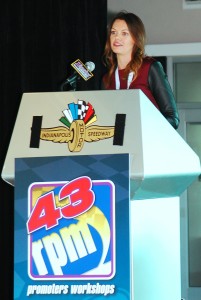 Those who listened to my talk in Las Vegas, Portland, or Indy, you heard about the scary reality that is the new Facebook. The old Facebook worked really well, with only a little bit of time, strategy or financial investment.
Those who listened to my talk in Las Vegas, Portland, or Indy, you heard about the scary reality that is the new Facebook. The old Facebook worked really well, with only a little bit of time, strategy or financial investment.
That’s no longer the case for two reasons: the Facebook algorithm and the Facebook IPO, which allows Facebook to monetize with advertising.
The Facebook algorithm – a mathematical equation made up of more than 100,000 factors – works to decide whether to show your content to your fans, in what order and how often. We talked about how to work technically with the algorithm to increase the amount of content that your fans actually get to see.
Basically, all of that advice boils down to this: give your fans what the want to see, how they want it, and when they want or need to see it.
But what do your fans want to see? That’s the most important question to answer if you want to be successful in your marketing, on Facebook and every other marketing channel.
And that’s what I’ll be talking more about in Daytona.
It’s not just about whether photos get more clicks than videos or text updates at 9:00am reach more fans than links at 9:05am. All of that is irrelevant if you’re not telling a story.
Or, even more importantly, a story that your fans are interested in.
Do you know what resonates with your fans? If not, it’s time to start paying attention to why your fans like you. There are plenty of entertainment options for them on a Friday night – ask any promoter. There are plenty of race car drivers and athletes out there to follow on Instagram.
Why you? Because of your story.
People have positive feelings towards other people and things for a variety of reasons. It might be because they feel accepted by you or the atmosphere you provide. It might be because they aspire to be like you or a part of the atmosphere you provide. It might be because you facilitate an experience that they want to have: a conversation-striking t-shirt, the perfect first date spot or a fun bonding experience with their family.
All of those reasons? They are their stories (with you as the co-star).
So if you want more likes, shares and reach, you have to create content that tells a story.
Want to really crush it on social media? Make it a story they want to be a part of.
xo.
Kristin
Off-Season Panic Setting In? How to Get Back on Track
At the end of last year, I gave you some advice on how to keep the offseason from getting you down.You can read it all here. One valuable piece:
“What you do in the offseason can set the tone for what you do the rest of the year. It’s the foundation of your season.”
I really feel that’s the case.
Unfortunately for many of us – myself included – the offseason has zoomed by and we’ve found ourselves, well, what’s the positive term for ‘looking down the barrel’ of the impending race season?
It’s so close.
And that’s so exciting, if we can stop breathing into a paper bag for long enough to realize it.
For all of you who join me in panic mode at this time of year – whether you haven’t gotten as far as you wanted to in your off-season progress or you’ve lost motivation in the midst of to-do’s – here are some tips to get back on track with your plan for getting back onto the track:
Make a list. It sounds simple, but just get it out of your head. Write down every single thing that you wanted or needed to get done before the season. Don’t let go of the things that you know you don’t have time to do – they’ll just haunt you. Get them on paper.
Prioritize. Now, find yourself another piece of paper and create two columns. Label them: ‘Need to Do’ and ‘Want to Do’. Put every single thing on your first list into one of the two columns. Don’t know where to put something? If you think about not getting that thing done in the next 4-6 weeks, how panicked do you feel? If you’re at a 10, it’s a need. If it’s a 2 – more like a disappointment – then it’s a want.
Set a goal for getting the ‘needs’ done. Pick the three or four most time-sensitive needs you have – getting an engine rebuilt, shoring up those rickety grandstands – and break them down into tasks. Set an intention of getting those done in a certain timeframe, and let go of the rest of the list. It’s not going anywhere.
Take Action. Do them. Repeat. As you move through that list, you’ll pick up quite a bit of motivation – and that’s one of the tricks to this process. Many people wait until they’re motivated, often by avoiding negative consequences instead of moving towards positive results, to take action. That’s a recipe for disaster. New studies are showing that we get motivation by taking action – so get started, and see how quickly you start knocking that list out.
Enjoy the process. When I feel backed into a corner, I often lose sight of why I’m doing whatever it is on my list. That’s the trick of the offseason – it’s more about the business of racing than the actual racing – and when you get behind on the operations side of things, it can seem more like business than fun.
Remember why you’re here. Why are you a part of this sport? Are you a talented driver? Do you love giving talented people a place to race, and bringing in the fans that cheer them on? Is the community better than any other circle you’ve ever experienced?
Do you have a dream?
Take a breath. Put down the paper bag. Smile, because you get to be a part of this great sport.
And get ready for some racing.
xo.
Kristin
P.S. Behind on the marketing side of your team? Do a search around the blog for tons of free information, or take it to the next level quickly with one of our on-demand workshops!
The Value of Working with the Media
Recently, one of our DirtyMouth Sponsorship Success Community members, late model racer Darin Henderson, posted about one of his marketing wins: a feature on the late-model-focused publication DirtOnDirt.com. In his post, Darin recognized the value of the media attention he received in continuing to grow his audience and build his fan-base and provide added value to current marketing partners and potentially attract new sponsors. 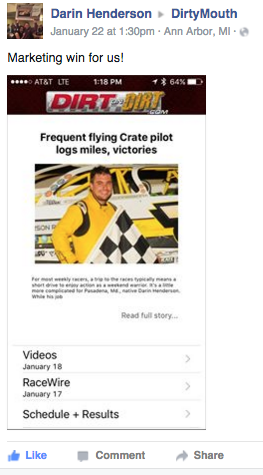
There is immense power in being featured in the media, both for your team or track and for your marketing partners, and I was really excited that Darin realized this.
With my background doing public relations , I often forget that not everyone sees how valuable media coverage is, and how straightforward it is to get some when you have a compelling story and you work professionally with the media.
Media coverage can:
- Expose you to new potential fans
- Expose you to new potential marketing partners
- Provide value to current marketing partners (by giving them additional reach beyond your core fan base)
- Give you a platform to share parts of your story that you haven’t shared elsewhere
- Allow fans to connect with you on a different level, through your voice or image on podcasts and video
- Provide an additional point of reference for the know-like-trust factor, often boosting sales and levels of engagement
- Allow you to create new messaging about yourself, your products, your track or your event
- Set you apart from your competition (and, no, that’s not just the racer in the trailer next to you or the track down the road)
- Provide hard metrics and credibility for marketing partners and other, bigger, media outlets
- Do so much more….
So, how do you go out and get this valuable media coverage? Let’s break it down.
- Figure out what your story is. What makes you unique? It’s not just racing. Are you an over-the-road trucker by day? A hockey player by night? Do you offer the only organic menu at an entertainment venue in your region (call me! wink.)? I could talk to racers and tracks for hours and hours about this (in fact, I do every single week…) but in a nutshell, ask yourself what would make you stand out in a crowd of racers, tracks, advertising mediums, entertainment venues, etc.
- Figure out where you’d like to get media coverage. Getting featured in racing publications is great, especially if your marketing partners are business-to-business (i.e. looking to sell to other racers or racing-related businesses). But there’s quite a bit of magic in looking to non-racing media, too. In fact, this was one of my specialties when I worked for the San Francisco 49ers – garnering off-the-field publicity for key players. Some of the players, Vernon Davis in particular, were interested in fashion, so we secured a fashion spread in a high-end local magazine. Delanie Walker, for example, is a car collector. So we got him featured in a few classic car outlets. It expanded the team’s reach into markets that weren’t directly football enthusiasts, and the players benefitted from that as well. So, you want to look at what makes you unique and look at media outlets in that industry or field. If you’re a chef, perhaps the Food & Wine section of your local newspaper would be interested in a piece on a chef that tears it up on the track after hours or rolls up his sleeves at the local race track?
- Do your homework, and then reach out. Reporters get lots (and lots!) of inquiries every single day, so you have to make it easy for them to choose to write about you. Do some research on pieces they’ve written before that might align with your story. Make sure that their audience would actually be interested in an article on your topic. Find their contact information and put together a pitch. It should be simple and concise – introduce yourself, give them a few bullet points on why your piece of news or story would be relevant to their audience and let them know that you’ll provide as much information as they need. If you have supporting media – pictures or video – that you can provide them with, mention that. Above all, respect their time and don’t pitch them stories that aren’t relevant or newsworthy.
- Be proactive. You cannot assume that media members – or other racers and event promoters, for that matter – are scanning social media for your pieces of news. Got a win? Send out a (well-written) press release to racing media members. Doing a great promotion or charity event? Let relevant media members know with a quick email or tweet. We live in a nice little racing bubble, so it’s easy to assume that everyone knows what’s going on at all times. They don’t. If you want press coverage, you need to do the heavy lifting and let them know about your great story or news item.
- And be nice, for goodness sake. You have no idea how many times I’ve watched a racer completely brush off a reporter in the pits. Think they don’t remember that? You’re wrong. No, reporters aren’t perfect either. Whether things are going swimmingly for you or you’ve just junked your favorite car, remember that reporters have a job to do and they’re a potential vehicle for you to create more fans. Yes, some of them are trying to get you to say something ‘interesting’ so they have a ‘newsworthy’ quote, but most aren’t from TMZ. They’re there because they, too, love the sport and need to give their fans a good story. A positive story. So don’t avoid them or be combative. Be nice. Even if they don’t include you in the story or mis-quote you, at least you treated them well and did your best to help them.
In fact, let’s just be nice to everyone, while we’re at it. And tell that reporter ‘thank you’.
Because real winners have manners. And fans.
xo.
Kristin
P.S. Got some great, unique coverage for your team, track or event? Feel free to share in the comments section or on our Facebook page!
How the Best Innovate, On and Off the Track
Want to take your marketing game to the next level, whether you’re a racer, track promoter or racing business?
Look outside of racing.
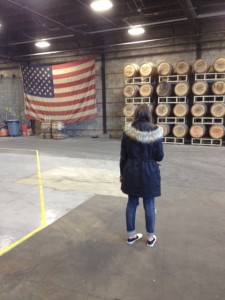
Getting inspired in Nashville over the weekend.
It might sound simple, but it’s worth considering.
Because the most successful people that I know in racing didn’t get there by modeling off of other racing businesses. They don’t stay at the top that way either. They look outside of the industry, and model bits and pieces of other successful businesses.
My business, and my customers’ and clients’ programs, have benefited both from my experience outside of racing and my eagerness to research, test and execute new tactics that other industries are having success with.
For example:
Want to offer fans better customer service? Don’t just look at what other tracks do. Consider what the best customer service providers, like Zappo’s, in the world do and how they empower their employees to enact their philosophy.
Want to entice more ‘casual’ fans in? Look at how other entertainment venues or, even, gas stations like Sheetz provide a winning model of custom, higher-end food and beverage options.
These are really straightforward examples, but that’s because it’s a straightforward concept: some of my best (and most profitable) ideas and strategies for my clients have come from studying the business of other industries that are seemingly unrelated.
How many brilliant crew chiefs found a technological breakthrough from an inspiration outside of racing? Probably more than we know.
It takes either an active level of curiosity or an active decision to ignore what’s in front of you and search for what’s better, or sometimes both. But it’s necessary if you want to be the best at what you do, whether that’s tuning shocks or launching a new sanctioning body.
Innovation is critical to your program, beyond just generating speed.
Want to take your team to the next level? Quit scoping out other racers’ graphic design or apparel. Look beyond another track’s menu. Stop comparing your ticket prices or number of divisions to the track’s up the road.
You’re not competing against them anyway.
Read a magazine outside of your industry. Go to a local bar or coffee shop. Listen to a podcast that has nothing to do with racing. Sign up for a talk or a class. Follow someone on Instagram just because they inspire you.
You never know when that twinkle of an idea will become your next big, amazing thing.
xo.
Kristin

Connect!